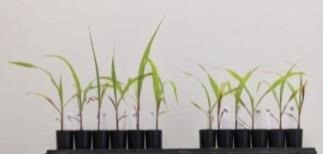Texas A&M AgriLife scientists are working to enhance corn’s resistance to insects such as fall armyworm by transplanting beneficial microbes found in corn’s resilient ancestor, teosinte.

An early reproductive stage teosinte plant showing silk from an ear. (Texas A&M AgriLife photo by Julio Bernal)
The work is urgently needed because fall armyworm, western corn rootworm and other insects are becoming increasingly impervious to existing control methods. Corn is among the most planted and essential crops around the world. In the U.S. alone, western corn rootworm causes more than $1 billion in damage to corn crops each year. Insects’ resistance to pesticides can lead to ramped-up pesticide use, which can create environmental problems.
By focusing on beneficial microbes from teosinte, the Texas A&M AgriLife research team aims to create an environmentally friendly insect control method specifically suited to corn.
The research was funded this summer by a $199,892 grant from the U.S. Department of Agriculture National Institute of Food and Agriculture. The grant builds on a seed grant from the Collaborative Research Grant Program of Texas A&M University and the Consejo Nacional de Ciencia y Tecnología, a Mexican government agency.
Leading the project is Julio Bernal, Ph.D., professor, Texas A&M College of Agriculture and Life Sciences Department of Entomology. Bernal is collaborating with Sanjay Antony-Babu, Ph.D., an AgriLife Research assistant professor with the Department of Plant Pathology and Microbiology, and Thomas Isakeit, Ph.D., professor and Texas A&M AgriLife Extension Service specialist, also with the Department of Plant Pathology and Microbiology.
Clues to insect control
A series of clues over the past decade gave the team the idea for the project. Bernal’s previous work, and that of others, demonstrated that teosinte is much less hospitable to insect pests than corn is. Meanwhile, studies also showed that the microbiome of corn, or maize, has changed greatly over the past century, diverging from that of teosinte. However, practically all the studies to date have focused on microbes living on and around the roots of corn and teosinte — the rhizosphere. In contrast, few studies have focused on microbes living inside corn tissues, especially in the leaves, Bernal said.
“Studies have shown that the rhizosphere does, in fact, affect insect resistance in maize and can improve it,” Bernal said. “But no one had looked at the microbiome inside maize tissues. We began looking into that.”
If teosinte’s microbiome holds answers for insect resistance in corn, seeking those answers in teosinte’s internal microbiome has several advantages to looking toward root surfaces or the soil. Teosinte’s internal microbiome must be compatible with the plant’s innate immune system. Hence, this microbial community is less likely to contain pathogens and more likely to contain species that would thrive in corn and benefit the crop.
Preliminary effects on growth, insect resistance
At the end of a growing season, the team collected dead teosinte leaves. The researchers then added those leaves to the soil where they grew maize seedlings.
“We saw effects on growth and insect resistance,” Bernal said.
In corn seedlings grown in soil treated with teosinte leaves, “resistance was much better towards the fall armyworm. This was very exciting because this was a very simple experiment, not sophisticated at all.”
A surprising snag
Next, the team worked to establish whether the leaves’ internal microbes, rather than those on the leaves, were indeed a key factor in resistance to fall armyworm.
Antony-Babu separated the bacteria from green teosinte leaves and applied the microbes to corn seeds. Bernal’s team then grew the seeds into seedlings.
“We ran the experiment, and it gave us totally different results than before,” Bernal said.

Corn seedlings treated and untreated with teosinte leaf microbiome inoculant. (Texas A&M AgriLife photo provided by Julio Bernal)
Antony-Babu suggested that both fungi and bacteria from the teosinte microbiome may take part in enhancing insect resistance. So, a fungal-bacterial mixture was applied to the corn seeds next. Now, the seedlings indeed grew better and had better insect resistance than the controls.
“Maybe there are some fungi that belong there,” Bernal said.
Next steps for insect control
Over the next three years, the team plans to refine the method and make it more reliable. The researchers will optimize the culturing techniques and the way they apply the treatment to the corn seeds. They will also look for effects against important pests other than fall armyworm, such as western corn rootworm.
Next, the team will identify the species making up the microbiome and determine a combination of species that are key for insect resistance.
“Maybe only 10 of the species create the effect,” Bernal said. “Once we know what species make it work, we can create the treatment from cultures in the lab. We wouldn’t have to go back every time to teosinte leaves.”
The study’s third year will include growing a small set of treated crops in the field as proof of concept.
“Commercialization is the obvious endpoint,” Bernal said.
If the team’s efforts eventually lead to a commercial product, pests would be less likely to evolve resistance to this mixture of microbes than to a single chemical treatment. And, corn producers would obtain an alternative, eco-friendly treatment against insects.
Source : tamu.edu